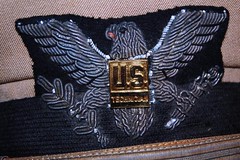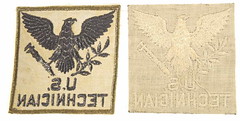Cast brass; motto: U.S. TECHNICIAN.
1 screw, 1 non-rotating point.
37mm x 48mm (LxH).
manu: Officer's Equipment Co. Madison, NJ.
mini device: 15mm x 19mm.
Circa 1950.
Joseph Tonelli's book, Visor hats of the United States Armed Forces: 1930-1950
With the onset of the Second World War, the technologies involved in weapon creation oftentimes surpassed the basic training of sailors, soldiers and their commanding officers. The technical advancements in aviation, computers, and RADAR required technical personnel of defense industry companies that created these new weapons of war to advise and train their military customers. The Navy, keen on maintaining hierarchical relationships and following Geneva Convention rules, and to insure the clear identification of non-combatants in its midst, drew up regulations for U.S. Navy Technician uniforms and devices. These regulations, for the most part, remain on the books and can be found buried in U.S. Navy and U.S. Marines uniform regulations. A survery of these regulations are as follows:
First public mention of the uniform was published by All Hands in October 1943:
New Insignia For Civilian Technicians
Civilian technicians, who may serve with the Navy, were authorized last month to wear a uniform similar to that worn by Naval officers, minus any insignia of rank or corps, or shoulder or sleeve marks. Caps with black chin strap and without cap device will be worn. Instead of Naval insignia, technicians will wear the insignia pictured herewith, on the left breast pocket of coat and shirt. (Details in N. D. Bul. [semimonthly], of 1 September 1943, R-1368.)
The insignia above was reproduced on uniform visor cap with a small gilt placard bearing the words "U.S. Technician" on the eagle's chest (detail toward the end of the post). By 1950, the elaborate device was no longer and was replaced with a gilt placard. All Hands also relates the same:
Navy Civilian Technicians Will Wear Uniforms With Emblem on Left Breast
By the 1990s, the uniform regulation for U.S. Navy Technicians became quite specific, and they were mandated to only wear uniforms in forward combat areas and during travel to and from such areas outside of the continental United States (or, on any other occasion as deemed fit by the Chief of Naval Operations). This is to establish their official status as a non-combatant.
A new directive authorizes civilian technicians serving with the Navy to wear uniforms that, except for insignia, are the same as an officer’s outfit.
For the most part, the uniforms will be worn by expert field engineers and scientists sent to Navy ships and shore bases by commercial companies to iron out difficulties the Navy is having with their equipment, Their most noticeable insignia, an embroidered badge about three inches square which shows an eagle and the words "U. S. Technician," will be worn on the left breast pocket of coats and khaki shirts. The uniform will be the same as a commissioned naval officer’s with the exception that no distinctive rank, corps device or other naval insignia will be worn. Plain buttons of the same size and color of naval officers’ uniforms will be worn on the coats. Here are the various insignia to watch for:
Cap insignia - Gilt badge one-and-a-half inches wide and one-and-seven-eighths inches high bearing the words "U.S. Technician," worn on the band of the combination cap with a plain black strap and plain gilt buttons.
Breast insignia - An embroidered badge three-and-a-quarter inches square. An eagle is shown clutching a group of tools in one claw and an olive branch in the other. The design and the words "U.S. Technician" are white on blue coats and blue on other coats and khaki shirts, on a background the same color as the coat or shirt.
Collar insignia - Gilt pin five-eighths of an inch wide and threequarters of an inch high bearing the inscription "U.S. Technician," for wear on both sides of the khaki shirt collar.
Garrison cap insignia - Same gilt pin as that worn on the collar. On the garrison cap it is worn on the left side only. As announced in BuPers Circ. Ltr. 142-50 (NDR, 31 Aug 1950), the uniform will be of benefit in establishing the technician’s status in event of capture by an enemy, will provide ready identification as contractors’ representative at naval activities, and will assist area commanders and commanding officers in their control over them.
The wearing of this uniform is limited to individuals authorized and designated by the Chief of Naval Operations.
U.S. Navy OPNAV INSTRUCTION 5720.3D § 9 states thus:
Articles of Uniform. The articles of uniform shall be the same as those prescribed for a commissioned naval officer except that no distinctive rank, corps device, or other naval insignia shall be worn. Plain buttons of the same size and color prescribed for naval officer’s uniforms shall be worn on coats. Female technicians shall wear either the garrison cap or beret; combination hat is not authorized.The U.S. Marine Corps has similar directives, however without the "combination hat" and the stipulation that anyone wearing a Marine Corps uniform must abide by USMC grooming standards.
Breast Insignia. An embroidered badge 3¼ inches square, consisting of a spread eagle, facing dexter; the left claw of the eagle shall be shown clutching a group of tools and the right claw an olive branch; immediately underneath the eagle shall be the letters: U.S. TECHNICIAN. The background of the badge shall be the same color as the coat/jacket or shirt, with the design and lettering white on blue coats and blue on other coats/jackets and khaki shirts. The breast insignia shall be worn on the left breast pocket of coats and khaki shirts for male technicians. The breast insignia shall be worn above the left breast pocket flap of the jacket (Service Dress Blue), for female technicians.
Cap insignia for male technicians. A gilt badge 1¼ inches wide by 1-7/8 inches high bearing the inscription U.S. TECHNICIAN. Worn on the band of the combination cap with plain black chin strap and plain gilt buttons. Cap insignia for garrison cap (male and female technicians) and beret (female technicians). A gilt pin 5/8-inch wide by ¾-inch high bearing the inscription U.S. TECHNICIAN. Worn on the left side of the garrison cap 2 inches from the front edge and 1½ inches from the bottom edge of the cap when the garrison cap is prescribed for wear by naval officers. For female technicians, worn on the beret, aligned approximately above the left eye.
Collar insignia. A gilt pin 5/8-inch wide by ¾-inch high bearing the inscription U.S. TECHNICIAN. Worn on both sides of the collar of the khaki shirt with the center of the insignia 1 inch from the front edge and 1 inch below the upper edge of the collar for male technicians. Worn on the white shirt collar with the center of the insignia 2 inches from the fold line at top of collar and ¾-inch from the forward edge of collar, for female technicians.
These directives are still in effect. In terms of the insignia that accompany this entry, they were manufactured prior to the Korean War - as evident by the lack of Institute of Heraldry (IOH) numbers and the wartime keeper screw bolt. In the past, GEMSCO and Officer's Equipment Co. manufactured U.S. Technician insignia; Dondero is presently the only supplier of the collar insignia to the USMC - I am unsure about the hat badge and if it is even produced. I have yet to see these plain buttons.
References:
Marine Corps Order P12304.1, 25 October, 1993
Contractor Engineering and Technical Services Personnel Manual.
Marine Corps Order P1020.34G MCUB, 31 March 2003.
Paragraph 8005, Civilians Serving With Marine Corps Units.
Office of The Chief of Naval Operations OP-09B23T, 1 June, 1994
U.S. Department of Defense Form DOD-OPNAVINST-5720-3D, § 9.
Nicole A. Lavine. "Tactical Safety Specialist diffuse potential hazards" in Observation Post. Twentynine Palms, California: 26 January 2007, p. A5.
Joseph J. Tonelli. Visor hats of the United States Armed Forces: 1930-1950.
U.S. Navy. All Hands October 1943, p. 69.
U.S. Navy. All Hands November 1950, p. 51.
USN Technician
Hat badge & miniature device; reverse, hallmark and screw post detail. 1950s.

USN Technician.
U.S. Navy officers' hat with U.S. Technician insignia
manu: Berkshire, New York, NY.
Circa Early Second World War

This khaki covered hat would have been worn with the jacket as detailed below. The hat itself has an early wartime Berkshire logo, and is the standard U.S. Navy officer model; the owner would have had to privately purchase the embroidered insignia. The rich embroidery is worth mentioning; it is speculated that the work was done in Great Britain - however, these findings are inconclusive.
Do note the U.S. Navy side buttons holding the chin strap - which is of the same width as those found on standard U.S. Navy officer hat.


USN Technician.
Breast cloth badge; obverse & reverse.
Circa 1950.


As previously mentioned, a great majority of U.S. Navy Technicians worked in the field of RADAR & ASDIC (SONAR), computational devices and propulsion systems newly adopted by the U.S. Navy over the course of the Second World War and continued to do so after the close of hostilities.
However, researchers and collectors oftentimes come across "emergency rates" or other insignia worn by sailors during this period who worked with the same technologies. The lower rates were hand-picked as evidenced by special aptitude during seamen training. The others were directly recruited by the U.S. Navy based upon prior civilian experience or training - they often became Petty Officer First Class or Chief Petty Officer after having completed boot camp; at the time, these CPOs were derisively called "Slick Sleeve Chiefs" due to the lack of service hash-marks. Directly-inducted Warrant Officers and newly-minted junior officers out of V-7 training with specialized knowledge were placed into special trade and officer corps groups (former and later). However, U.S. Technicians were another class entirely, they "belonged" to their corporations, had no military training and were "lent" for the duration to train or advise the later, repair or install their equipment or simply to operate it.
A means to determine a wartime and post-war U.S. Technician patch is the lack of a border on the former.
USN Technician.
Breast cloth badge; obverse.
From the collection of David Collar.
Note: The eagle is clutching arrows as opposed to a wrench.

USN Technician.
Khaki Coat
circa Second World War

Despite regulations stating otherwise, this belted khaki coat has U.S. Navy officer gold buttons. The main difference between this jacket and its naval and maritime counterparts is the fact that it lacks loops for shoulder boards. It was also an expediently tailored piece as it not only lacks an interior liner, but also interior pockets - this common to other period pieces. The buttons are removable for coat cleaning in ship's laundry.
Note: The eagle is clutching a wrench (of sorts) and a hammer.



USAAF Technician.
Silver plate; motto: U.S. TECHNICIAN.
Silver plate; lettering: A.S.C..
device: 15mm x 19mm.
Reverse: non-rotating points.
manu: no hallmarks or silver content noted.
Circa Second World War through 1947 (n.b. ASC became AMC in Dec. 1947).
from the collection of Joe Weingarten.
Rarely seen, these silver collar devices were worn by civilian technicians attached to the U.S. Army Air Forces Air Service Command at installations such as Wright Field - from 1948, Wright-Patterson Air Force Base. These technicians began working at Wright-Patterson from the Second World War through the Vietnam war when they were replaced by civilian civil service employees of the U.S. Air Force Material Command. They performed tasks much like their U.S. Navy counterparts; if such insignia is still worn or used, I am unaware.


Korean War Period, U.S.A.F. Technician shirt patch.
More on the USAAFASC activities at Wright-Patterson, may be found here.


